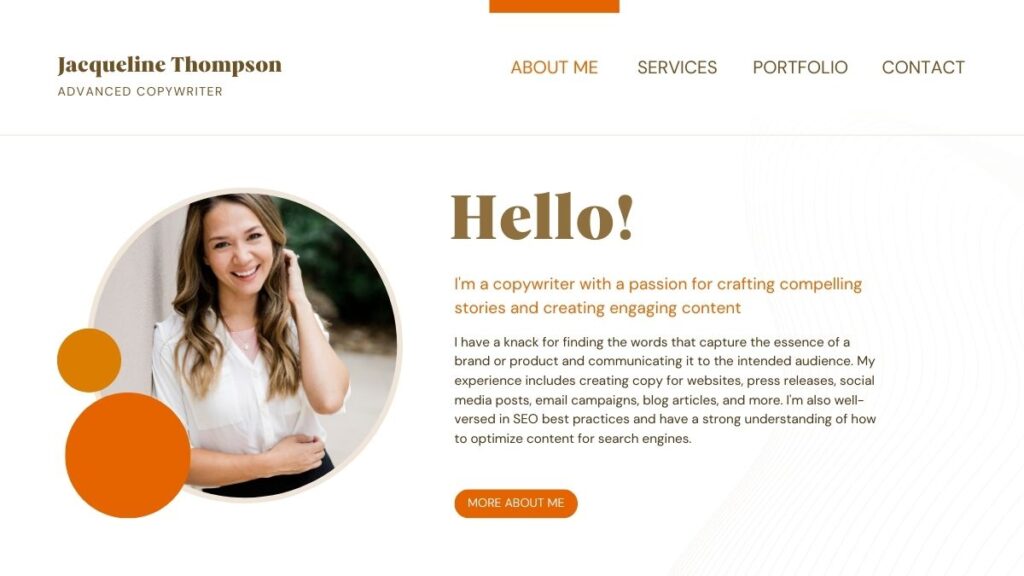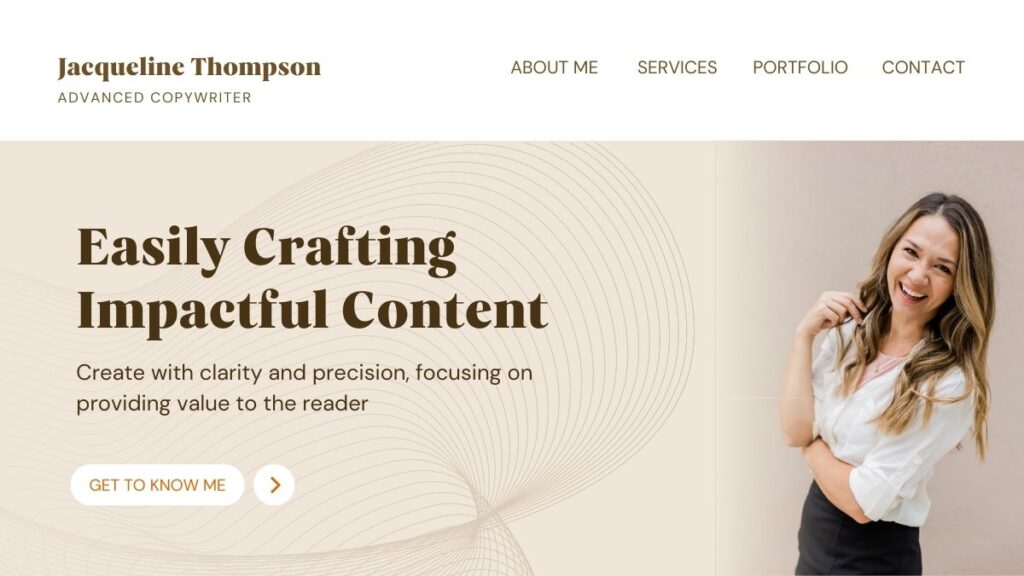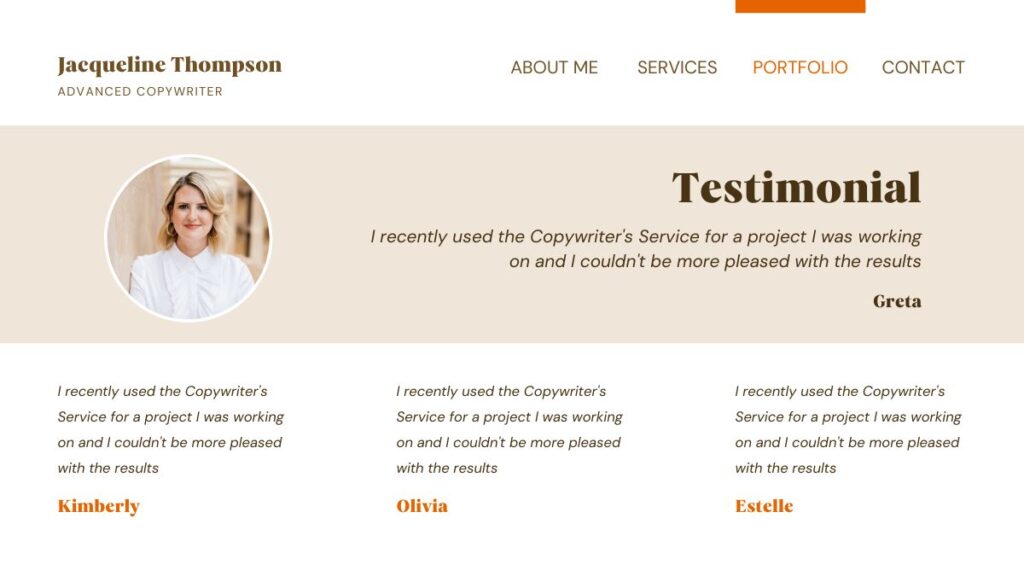
If you’re a budding freelancer, you know how competitive the market is getting, right?
There are so many new freelance professionals and job-seekers everywhere in the freelancing domain that to stand out, you need to portray yourself best.
As a freelancer, one of your most important responsibilities to attract potential clients is creating a carefully curated, personalized, strategic, and professional freelance portfolio for beginners.
A great portfolio should not only showcase your talents, work experiences, and strengths but also give it a personalized look to it.
Nowadays, having an impressive portfolio with an increased number of clients is most beneficial.
This helps to make your job and income much more steady than an average job with one employer.
You must be wondering, “How do I make a freelance portfolio?” or “How do I make a beginner portfolio?” worry not, folks!
Because in today’s blog, we are sharing with you all the information you need to create a professional portfolio.
Let’s get into the details!
What Is A Freelance Portfolio?

A freelancer portfolio, also popularly called a professional introduction letter, is a career portfolio of one’s best work experiences, education, skillset, projects, talents, and achievements.
This is your first impression in front of potential clients, and your portfolio could be your one-true ticket to a dream job.
Even if you’re a beginner, you can still include so many different things on your portfolio, such as school projects, seminars, academic work, workshops attended, competitions, certificates, etc.
And by the way, if you’re wondering about ‘How to start freelancing?’, refer to this blog here where we’ve explained in detail about freelancing.
What Is A Portfolio Sample?
A portfolio is the strongest weapon a freelancer can hold.
A portfolio sample is a representative piece or project that showcases your skills and expertise. It gives potential clients or employers a glimpse of your work and serves as a snapshot of what you’re capable of. Think of it as a sneak peek into your talent and creativity!
Refer to these professional freelance portfolio examples to learn more about creating the best one for yourself.
No matter whether you’re a UI/UX designer, art director, photographer freelancer, web developer freelancer, or media manager, you can create a portfolio uniquely using Pixpa.
Some of the great freelance portfolio examples are:
- Web Developer Portfolio
- Photographer Portfolio
- Makeup Artist Portfolio
- Freelance Artist Portfolio
- Teacher portfolio
- Student Portfolio
- Freelance Design Portfolio
- Content Marketer Portfolio
- Engineering, Development, Business Portfolio
- Freelance Writer Portfolio
9 Effective Tips To Build A Winning Freelance Portfolio
Here we will discuss 9 solid tips to help you build your best freelance portfolio.
- Fix Your Domain And Audience
- Highlight Your Best Work And POR
- Include Contact Information
- Build A Website For Your Freelance Portfolio
- Avoid Unnecessary Links Or Details
- Upload Relevant Work
- Make Use Of SEO And Self-Promotion
- Personalize Your Freelance Portfolio
- Include Client Testimonials and Update them Regularly
1. Fix Your Domain And Audience

This tip is pretty self-explanatory, don’t you think?
Any work or freelance business you want to start needs to have a foundational domain upon which it is based.
It means what you create and offer(if services) to other people should be about a particular domain so that you target the right audience.
Choosing the right domain is the most critical step for your freelancing journey.
It could be anything from blogging, marketing, photography, writing, speaking, development, etc.
Your portfolio should be clear about what specific skills you possess, what services you can offer, and your freelance rates.
You must include how much you charge or your freelance rates/pricing procedure.
If you want to learn about how to set freelance rates then we have a dedicated guide for you. Check it out now!
Always write professionally and crisply.
2. Highlight Your Best Work And POR

You should definitely include relevant past projects and work experiences in your freelance portfolio, but remember to highlight your best works.
For example, bold and highlight the most prestigious project or job you worked at in your portfolio website.
Remember to be yourself and showcase to the world who you truly are, what are your work ethic style, and your strengths.
Also, make sure to bring light to any POR (position of responsibility) you were handed previously.
3. Include Contact Information

Your freelance portfolio will be built to attract potential clients for freelance jobs or to build a successful freelance career.
Hence, do not forget to add your contact information to your portfolio and the links to all your social media handles, including your email address.
4. Build A Website For Your Freelance Portfolio
You will find plenty of third-party sites to act as a host for your portfolio.
Instead of hosting it on other platforms, you can create a website for yourself that will allow you to customize it yourself.
With your freelance portfolio website, multiple special features and templates can be added to your portfolio design to improve its look and functionality.
And the most surprising thing? You don’t need to learn a single line of code to create your website.
Use a website creator platform like Pixpa, that will help create your very own personalized and professional freelance portfolio website.
5. Avoid Unnecessary Links Or Details
Avoid any unnecessary linking to other sites or pages from your freelance portfolio.
It is best advised that you keep the task of the viewer/ client easy and simple by including everything that is required in one place.
However, you can provide links to necessary aspects like your social media handles or a link to your Freelancer.com or Upwork profile so that the clients can see the extent of your current work profile.
6. Upload Relevant Work
Whenever you’re applying for any job, think from the point of view of the client/employer.
What would they seek?
They would seek the employee that best suits their company or brand’s needs.
It’s not about being the best among the crowd.
Rather, offer your best contribution possible.
Make sure to upload and present only relevant work experiences, projects, and achievements to showcase yourself as best suited for the job.
7. Make Use Of SEO And Self-Promotion

So, now you’ve created your most impressive professional freelance portfolio to attract potential clients.
Do you think this will be enough to drive traffic and bring clients to your site?
No, it isn’t.
This is where marketing and self-promotion come into play.
You need to promote yourself on every social media platform possible, especially on job recruiting platforms like LinkedIn.
Have you heard of SEO?
SEO, Search Engine Optimization, is another powerful tool that you must use while promoting your freelance portfolio website.
SEO will help to promote your website in a very simple and efficient manner and drive immense traffic organically (through Google’s search engine results).
SEO practices include using the right keywords, external linking, clear URLs, images/videos on your site, etc.
Furthermore, if you wish to, you can use marketing pop-ups, announcement bars, cookie consent bars, etc., to boost your site’s reach.
8. Personalize Your Freelance Portfolio

Do you like reading boring long-form content and pages that only include heavy information?
No, right?
It would seem very mundane if you make your portfolio strictly business-oriented and only adhere to showcasing your skills and projects.
To bring life to your freelance portfolio, we recommend you personalize it.
Add something about yourself and make your digital portfolio showcase who you truly are as a person besides a person looking to be hired.
We advise you to add an ‘About Page’ on your website.
This is where you could include your name, where you come from, where you currently reside, and include a few lines about what makes you ‘you.’
You could also self-design your website’s template or incorporate personal brand logos or custom designs that reflect your profession and domain.
9. Include Client Testimonials and Update them Regularly

Besides work samples, make sure to reach out to past or current clients to include testimonials.
This way, you’ll promote yourself and make your online portfolio very strong and trustworthy.
Do you do proper research and read reviews before buying something online?
How does this help?
It helps you gain trust.
The more the number of positive reviews, the more probability of that product being sold.
Similarly, we want your clients to trust you and your portfolio to offer you work through positive reviews from other clients.
Lastly, on top of all this, remember to keep updating your freelance portfolio regularly.
Be it your contact information, new projects, new skillset, new job, etc.- always update your portfolio at the right time.
Wrapping It Up
Building a winning freelance portfolio requires a strategic approach and a touch of creativity. It’s not just about showcasing your work; it’s about telling a compelling story that captivates potential clients and sets you apart from the competition.
By following these nine effective tips, you’ll be well on your way to creating a great portfolio that leaves a lasting impression.
Remember, your freelance portfolio is a powerful tool that can open doors to exciting opportunities.
So, invest the time and effort to make it shine, and let your talent speak for itself.
If you have prepared your freelance portfolio, you must start applying to freelancing projects. Here are the best freelancing websites to get high-paying freelance projects.
Good luck on your freelance journey!
For such informative blogs, stay connected to PenChise!
You can also get in touch with us on Instagram, don’t forget to hit the follow button.
Frequently Asked Questions About Freelance Portfolio
1. Can I put freelance work on my portfolio?
Yes, you should!
To showcase all your past relevant work, you must include any relevant freelance work that you’ve done under other clients.
2. How do I make a portfolio with no experience?
Every beginner freelancer has this dilemma-“How do I start a freelance writing portfolio with no experience?”.
Adding any high school projects, achievements, participation in competitions, seminars, etc, will help enhance a beginner portfolio.
Apart from this, if you’ve never been hired before, start writing samples to be put up in your resume and portfolio.
You can write samples regarding different blog topics on the Internet, interview a friend or someone you know who’s doing well professionally, and then write about it as a blog.
3. What should I avoid in freelancing?
Here is everything you must avoid in freelancing:
- Not keeping a contract with your clients
- Not charging enough for your work
- Using AI to write your content
- Not managing your time
- Not promoting yourself(through blogging and networking)
- Saying Yes to everything
- Not having work and time boundaries
4. Can I pay someone to build my portfolio?
Yes! You surely can.
You can hire portfolio design experts from popular sites like Upwork, Fiverr, Format.com, etc.
If you can afford to hire someone to make you the most impressive portfolio, then go for it.
5. What not to put in a portfolio?
Here is everything you should not put in your portfolio:
- Your whole life story
- Every design/project ever made
- Confusing or messy template
- Just one kind of work
- Link unresponsive sites/pages
- Too simple and static presentation (include 3D designs and movements)
- Only final products/projects (without any explanation)
6. What should a freelance portfolio include?
A first-timer might be very confused and think- “What should I write in my freelance portfolio?”.
So, here is a simple answer to this question:
- A captivating introduction that highlights your skills and expertise.
- A diverse range of your best work samples showcasing your versatility.
- Client testimonials or reviews to build trust and credibility.
- Clear contact information for potential clients to easily reach you.
- Relevant certifications, degrees, or training to demonstrate your qualifications.
- Links to your professional website or social media profiles for further exploration.
- A well-organized and visually appealing layout that grabs attention and leaves a lasting impression.
7. How do I create a virtual portfolio?
Creating a virtual portfolio can be an exciting way to showcase your work and talents to potential clients or employers. It’s like having a digital resume that speaks volumes about your skills and accomplishments.
Here’s a step-by-step process of how to create a captivating virtual portfolio:
- Determine your focus
- Collect your best work
- Choose a platform
- Design your portfolio
- Organize your work
- Craft compelling descriptions
- Include contact information
- Optimize for search engines
Remember, your virtual portfolio reflects your abilities and professionalism, so take the time to create a captivating and well-presented showcase of your work. Regularly update it with new projects and keep it organized to leave a lasting impression on those who view it.
Happy portfolio building!




